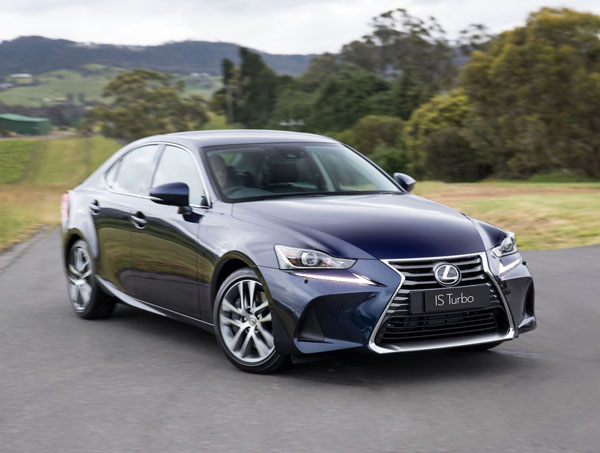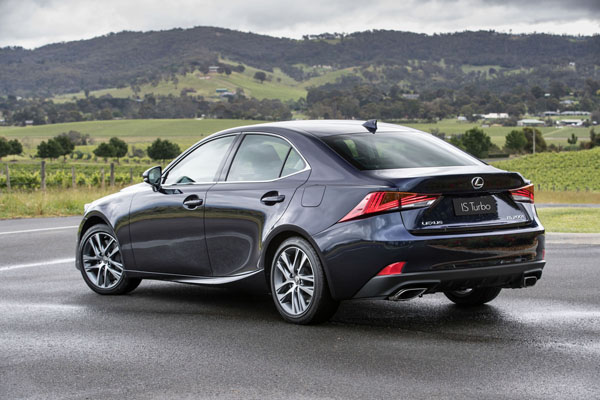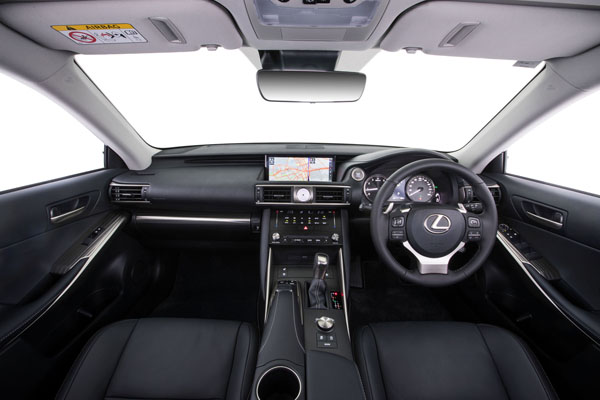
Of all the Lexus lines, the IS, with 40,000 delivered Down Under, is the model Australia has taken to its heart. Across four generations the IS Line has been known for its trendsetting design and the latest lot to land is no exception.
The new models feature exterior and interior styling changes, as well as improvements to the display screen and audio system. The range incorporates the full suite of Lexus Safety System+ technology. The Lexus IS Line is available as the IS 200t with the recently launched 2.0-litre turbocharged engine, the IS 350 using a 3.5-litre twin-cam V6 engine and as the 300h petrol-electric hybrid.
The Lexus IS 200t comes in three variants – Luxury, F Sports and Sports Luxury – with a range of enhancement packs. Prices open at $65,953, on the road, for the Luxury version and top out at $85,985 for the Sports Luxury, again on the road.
STYLING
Lexus obviously wanted to draw special attention to the IS Line as it has the company’s signature spindle grille, arrow-look headlamps, broad taillights and sports-style exhaust. Together with twin-spoke 17-inch wheels.
The F Sport takes on an even more aggressive character with expanded spindle grille and 18-inch wheels adding to LED daytime running lights and powerful LED headlamps, which not only light up quicker and shine brighter, but use less ‘juice’.
Needless to say, the all-round body shape is sleek and sporty, which not only looks the part, but with a low drag co-efficient of 0.28, efficiently cuts down wind noise and saves fuel.
INTERIOR
The IS Line may be the entry level to the marque’s premium sedan range but the cabin is the standard high-end Lexus layout, with the range topping Sports Luxury model more so.
The boot is certainly cavernous – enough for the golf clubs, ladies and gents – but suffers slightly from a slim opening and high loading lip. The rear seat backs fold flat(ish) to provide room for longer objects.
INFOTAINMENT
Virtual instruments of the multi-information display can be reconfigured at the push of a button to display exactly the information the driver wants, from audio settings to engine data, while the Lexus Remote Touch controller (joystick) on the centre console looks after audio, climate control and satellite navigation.
Lexus has always made a song and dance about its Mark Levinson audio system found in its upscale vehicles, including the IS Sports Luxury. The system calls on 15 speakers scattered around the cabin for optimum sound reproduction.
Bluetooth connectivity expands the possibilities of expanding a music library.
ENGINES / TRANSMISSIONS
Euro 5 compliant, the 2.0-litre turbocharged engine puts out 180 kW of power at 5800 rpm and 350 Nm of torque from 1650 to 4400 revs. Matched to the Lexus eight-speed Sports Direct Shift transmission, it has official combined urban / highway cycle fuel economy of 7.5 litres per 100 kilometres, but see our results in the Driving section of this review.
SAFETY
A full suite of Lexus Safety System+ technology, designed to provide maximum driver control, especially in critical situations, is taken up for the first time on IS.
The LSS+ is made up of a pre-collision safety system, active cruise control, lane departure warning+ with sway warning, and automatic high beam. All models have 10 airbags, reversing sonar, and rear-view camera with guidelines.
The bonnet pops automatically to help cushion any impact between the vehicle and a pedestrian.
DRIVING
Seats are snug and supportive laterally, if a little tight fitting for the broader back. The driver’s seat is 10-way power adjustable, so there’s hardly a posture that can’t be accommodated.
The stop / start engine system works with hardly a murmur, getting the car under way with ease. No jitters here.
Not that the Lexus IS 200t shot out of the blocks, as it were, a claimed zero to 100 kilometre sprint timed at 7.0 seconds by the maker seemed a tad optimistic, even with turbo heavy breathing.
The test car fuel consumption reached a surprisingly high 14 litres per 100 kilometres in the suburbs but showed much more efficiency at 6.3 litres per 100 kilometres on a motorway run. Lexus claims 7.5 overall.
The transmission offers D (automatic) or M mode, which has full torque-converter lock-up from second to eighth gears for ‘clutch-less’ manual shifting. Down changes in M mode are made in just 0.2 of a second.
In addition, the IS 200t is linked to the Lexus Drive Mode Select with Eco, Normal, Sport and Sport+ functions, the last pair making for more agile handling through sharpened steering and suspension.
Ride and handling on test ran true to some serious engineering study. Lexus went the full distance when developing the steering, with engineers putting in fine-tuning at Germany’s famed Nurburgring and Japan’s Autopolis, Fuji Speedway, Sportsland SUGO and Soegaura Forest Raceway. The result is better response to input and greater driver feedback. Front-brake air ducts also came in for special attention to optimise brake cooling.
Adaptive Variable Suspension (AVS) monitors and controls all four dampers at the same time to suit conditions and driving preferences. It aids ride comfort when driving on rough roads by lowering the damping force, but can also deliver a sporting drive with greater response and handling stability with increased damping when Sport S+ mode is engaged. AVS also interacts with vehicle management and pre-collision safety system to optimise damper rates and prepare the vehicle where danger lurks, adding a sense of confidence to the person behind the wheel.
SUMMING UP
There is no denying the Lexus IS 200t Sports Luxury is different, the test vehicle polarising attitude to its looks. Splitting roughly 50:50, few observers were left undecided; loving or hating. On the other hand, the 200t performance was quite mundane.
AT A GLANCE
MODEL RANGE
Lexus IS 200t Luxury: $65,953 on road
Lexus IS 200t Luxury + Enhancement Pack: $69,055 on road
Lexus IS 200t F Sport: $75,110 on road
Lexus IS 200t F Sport + Enhancement Pack: $79,230 on road
Lexus IS 200t Sports Luxury: $85,985 on road
FEATURES
New-design front bumper, spindle grille, LED headlamps, daytime running lamps, rear combination lamps, trapezoidal tips on dual exhaust
New-design 18in alloy wheels
Exclusive exterior: front grille and bumper side garnish, rear bumper lower, F Sport badges Naguri-style aluminium ornamentation Customise mode on Drive Mode Select 10.3-inch electro multi-vision screen Improved Lexus Remote Touch controller with back and enter switch on extended palm rest Improved parking-assist display and functions Revised meters, clock, steering-wheel switches, shift-lever knob, centre-console cup holders, door handles, electro-chromatic rear-view mirror, knee pads Revised panels – audio, heater control, ornamentation, door switch trim Lexus Safety System +
Pre-collision safety system with autonomous emergency braking, active cruise control and hill-start assist control
Blind-spot monitor and rear cross-traffic alert
15-speaker Mark Levinson audio
Tilt and slide moonroof
Electric rear sunshade
SPECIFICATIONS (Lexus IS 200t 2.0-litre turbo-petrol sedan)
ENGINE:
Capacity: 1.998 litres
Configuration: Four cylinders in line, 16-valve DOHC dual VVT-i turbocharged with intercooler
Maximum Power: 180 kW @ 5800 rpm
Maximum Torque: 350 Nm @ 1650-4400 rpm
Fuel Type: Petrol 95 RON or higher
Combined Fuel Cycle (ADR 81/02): 7.5 L/100km
CO2 Emissions: 175 g/km
DRIVELINE: Eight-speed sequential sports programmed direct shift with paddles
DIMENSIONS, WEIGHT AND CAPACITIES:
Length: 4680 mm
Wheelbase: 2800 mm
Width: 1810 mm (mirrors folded)
Height: 1430 mm
Turning Circle: 10.4 m
Kerb Mass: 1680 kg
Fuel Tank Capacity: 66 litres
BRAKES:
Front: Ventilated disc
Rear: Ventilated disc
STANDARD WARRANTY:
Four years / 100,000 km













